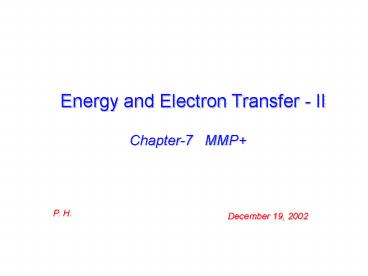Energy and Electron Transfer II
1 / 18
Title:
Energy and Electron Transfer II
Description:
Diffusion coefficient (D) of benzene (25 C) - 2 x 10 5 cm2/s; if we assume the ... size of several solvent molecules (e.g. x ~ 10 , equivalent to about 2 benzene ... –
Number of Views:64
Avg rating:3.0/5.0
Title: Energy and Electron Transfer II
1
Energy and Electron Transfer - II
Chapter-7 MMP
P. H.
December 19, 2002
2
Marcus Theory
-DG ls lv
Log k
normal
Inverted
-DG
Acc. Chem. Res., 1996, 29, 522
3
Example
kR gtgt kI
J. Am. Chem. Soc., 1989, 111, 8948
4
l 0.39eV
5
Contact and Solvent Separated Radical Ion Pairs
CRIP
SSRIP
A
D
D
A-
6
CRIP SSRIP - An example
DG2 1.8 kcal/mol
k1 values depend on solvent polarity
Dicloromethane -108 Hexane gt 1010
Also more solvent reorganization for SSRIP than
CRIP
7
CRIP and Exciplexes - The Transition
8
Electron and Energy Transfer Equilibria
Cant even happen without
Energy transfer equilibrium
9
Thermodynamics of the Equlibria
For rigid systems
For example..
DS - 0.04 gibbs/mol
DS - -1.8 gibbs/mol
10
Electron Transfer Equilibria
Cannot observe the equlibrium if
kbet gtgt ket
11
Chemiluminescent Ion Recombination
1
2
Marcus Effect
12
Role of Diffusion
- Diffusion and collision
- DA becomes DA
- DA breaks up into D and A
13
Rate Constants
- kOBS, is close to calculated kDIFF.
- kOBS is a function of T/?.
- kOBS is essentially invariant for quenchers of
widely varying structure. - kOBS reach a limiting value which corresponds to
the fastest bimolecular rate constant measured
for that solvent.
Obscured the Marcus Inverted Region
14
Cage Effect
15
Diffusion - Distance/Time Relationship
Diffusion coefficient (D) of benzene (25C) - 2
x 105 cm2/s if we assume the encounter to be
over when one of the molecules has traveled a
distance equivalent to the size of several
solvent molecules (e.g. x 10 Å, equivalent to
about 2 benzene molecules), then we obtain a
rough estimate of the time required by applying
above equation of about 2.5 x 1010 s.
16
Effect of Charged Species
17
Transient Effects on Quenching
With Incresing Time
18
Static Quenching - Perrin Model
ln (? /? ) V NA A
R (in Å) 6.5 A1/3
(with A in M units)































